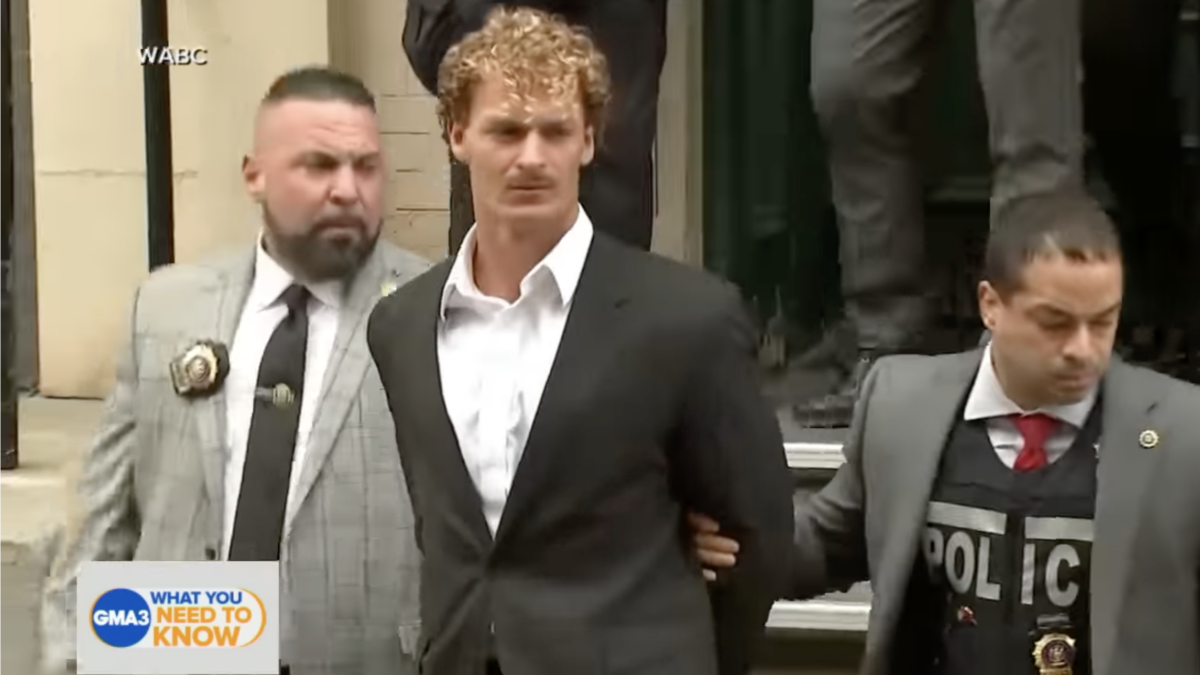From Rosa Parks to George Floyd, the left has reduced complex events to singular images that help its cause. Parks, for example, was a lifelong activist before the bus incident. George Floyd was a massive violent criminal high on meth and fentanyl. The screaming woman in the “Little Rock Nine” photo became close friends with the girl she yelled at, and Jane Roe became an anti-abortion activist, at least for a while. But these details don’t matter. America’s ceaseless leftward march runs on reductive imagery. Poke the right until it bites, snap a picture of it, and use it to win.
The left is now trying to do this with its manufactured image of Daniel Penny’s arrest. It wants us to see a brusk, racist, out-of-control white man finally, thankfully, corrected by the rainbow alliance.
Given that Penny surrendered himself, his photographed perp walk was entirely unnecessary, conducted only for the sake of theater. But not every manufactured image works out the way they want it to.
Bernie Goetz
When Bernie Goetz shot four black subway attackers in the 1980s, the left painted him as a crazed racist, but he became, much to their surprise, a local hero among New Yorkers regardless of race or politics. Liberal DA Robert Morgenthau — a DNC fixture if there ever was one — had to charge him twice to even get an indictment. At trial, the jury acquitted Goetz of everything besides a gun charge, for which he served eight months.
Malcolm Gladwell later identified Goetz as the “tipping point” between hellish 1980s New York and the pinnacle years of the 1990s. Having worked at the Manhattan DA’s office under Morgenthau himself — the same office where Penny’s fate now lies in the hands of Soros-funded DA Alvin Bragg — I can say for certain that the Goetz case serves as a foundational New York myth for cops, prosecutors, and citizens alike. Even as recently as 2017, a Brooklyn DA refused to charge William J. Groomes, who shot and killed a guy on the subway, even though Groomes himself seems to have initiated the conflict. Despite being a working-class victory, the Goetz case is not seen as a Dem win.
And now this one too is blowing up in their faces. In the image, Penny looks like a superhero oppressed by a dark and grumpy empire. It has already sparked $2.4 million and counting in GiveSendGo donations, a link to which both Google and Fox News attempt to hide. Venomous headlines sought to control the damage: “The Right Has Raised $2 Million For the Guy Who Choked a Homeless Man to Death.” They tried different angles, upping the contrast and making it fuzzy, and making it a collage with other, darker images. They even sent in a body language expert for reinforcements.
“He believes he’s highly attractive. It’s obvious his appearance is important to him,” a “body language expert” told The Sun. “He’s not showing fear, he’s not showing shame.”
None of it worked. Penny still looks like a total Chad, and everyone knows it. When I posted the image on Instagram without comment, my gayest, most progressive friend DMed me: “he can choke me to death any time.” Nobody is buying that this guy is an evil racist. He and his family have been incredibly smart and disciplined about staying silent so as not to fall into any rhetorical traps.
The reason the image backfired is because of a principle best articulated by Osama bin Laden: “When people see a strong horse and a weak horse, by nature they will like the strong horse.” You see this same pattern replicated elsewhere in culture right now, such as in the Bud Light fiasco, as self-hating propagandists scramble to create images that aren’t as ugly as their souls.
Urban Legend
Every now and then, an actual superhero appears. They’re not super because of their physical powers, but because of their heightened image in our collective consciousness. Some criticize this mythologization, but why? Humans create demi-Gods; it’s just what we do. In being instantly elevated to myth status, Daniel Penny isn’t “like a superhero,” he actually is one.
Behold the most popular movies of the ‘60s, ‘70s, ‘80s, ‘90s. All kinds of movies, all kinds of stories, all kinds of protagonists. Then in 2000, abruptly, only one kind of movie, only one kind of story, only one kind of protagonist: the superhero.
Most people pass this off as global monoculture. Sheep love big explosions and recognizable IP, so that’s what they get.
But I take a contrary view: Our love of superheroes betrays an innate populist intelligence. It reflects an overwhelming frustration at our loss of control, especially in the cities. Sheep don’t turn to superheroes only for escape, but for hope too.
Western society grounds itself in the rights of the individual, yet gig-ified techno-urbanity entirely subsumes the individual into its panopticon. Work. Live. Play. All in your neat little box. We own nothing, and we’re not happy — pillars of salt crumbling at the hands of an invincible surveillance state that packs us in like sardines.
Only an individual with great powers — powers that match that of industrialized urbanity itself — can save us. So Batman fights corrupt Gotham. Superman protects innocent Metropolis. Spiderman spins his web on erratic New York. Lately, we mix and match our superheroes and their cities, sampling them like our flights of “local” IPA.
Neely’s recorded death transformed Penny into something far greater than himself: a literal urban legend. Not just because Penny chose to risk his life protecting innocents on a subway car, but because he’s up against monumental forces of evil and their best weapons: the violence of the state-sanctioned drug zombie, the corruption of the Soros-funded DA, and the venom of the corporate media.
What sets superheroes apart from normal heroes? Heroes vanquish threats to innocent people. Superheroes take it a step further. They don’t just vanquish the threat, they go to the source of the problem. The source is always conveniently embodied by a supervillain.
Supervillain
Supervillains, usually out of resentment from past wrongs, decide to take out their fury on the world by trying to conquer it. They are the “final boss” in a third-act showdown, the brain criminal behind the body criminals that the superhero faces in the first act. At the core of supervillain efforts always lies some half-brained moral plan about how things will be better for everyone once they’re in control, even if we can’t understand it yet.
George Soros, a “global citizen,” never sets foot on the streets of cities he corrupts by electing ultra-liberal DAs that refuse to enforce the laws. Working-class, ordinary people have to send their children through dangerous filthy parks and subways because a random man from Hungary has decided it must be so.
Soros shares a similar backstory to the X-men supervillain Magneto, which is why Elon Musk just tweeted that Soros “reminds [him] of Magneto,” and that Soros “wants to erode the very fabric of civilization. He hates humanity,” which is something you’d only say about a supervillain. Magneto turned against humanity after being thrown into a concentration camp during World War II. A Hungarian Jew, Soros is also a Holocaust survivor who helped the Nazis confiscate fellow Jews’ property, something he is on record saying he doesn’t regret.
Even as crime rates spike and innocent people pay the price for Soros’ strange ideology, his true motivations remain shrouded. But they aren’t really mysterious at all. Sometimes the simplest explanation is the right one. Soros isn’t “like a supervillain,” he literally is one. He’s driven by a genuine hatred of humanity. That’s it.
The Big Character Poster
Like all fundamentally Marxist regimes, ours struggles with naturally occurring heroism. Moral flatness abhors tall trees. Historically, totalitarians solve this via blind adoration for a handful of leaders: cults of personality.
This also works in the other direction. Totalitarians form anti-personality cults toward their enemies — Orwell’s “two Minutes Hate.” During the Chinese Cultural Revolution, a communist takeover that saw students literally imprisoning their teachers on campus, Red Guards used “Big Character Posters” to identify the crimes of their enemies. They were sort of text-only wanted posters put up in public places with long lists of accusations toward specific individuals. They often preceded struggle sessions.
The Daniel Penny arrest photo is an American Big Character poster. His stated crime is racist violence, but this is obvious fiction. In reality, his crime is being white, strong, and bold enough to stand up to the regime’s drug-addled shock troops, on whose behalf they willingly destroy entire cities. Penny violated their ideology that “protects the most vulnerable,” but their real ideology is resentment, and the real protectors of the vulnerable are who they resent.
But unlike a Big Character Poster, an image speaks words of its own. In warping truth, the regime has flipped a hero into a villain. It does this a lot, and usually it works. But there’s something different about Penny, just as there was something different about Goetz. They were meant to be images of fear and division, but they were transmuted into images of strength and honor.
We’re naturally drawn to them, these strong horses next to weak ones. They both did something we all yearn to do — a fulfillment of the hopes we pin on dreams and superheroes: First, to protect innocent people against bodily harm. Second, to stand up to an oppressive regime. And third? To look great doing it.









